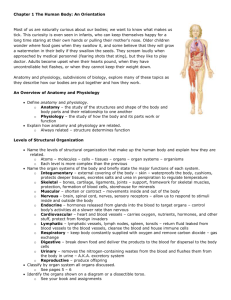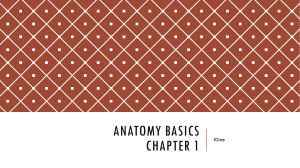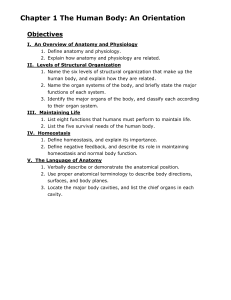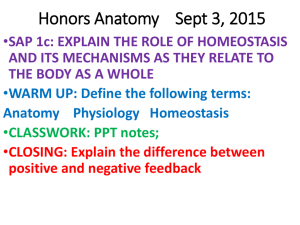Ch 1a. PowerPoints
advertisement
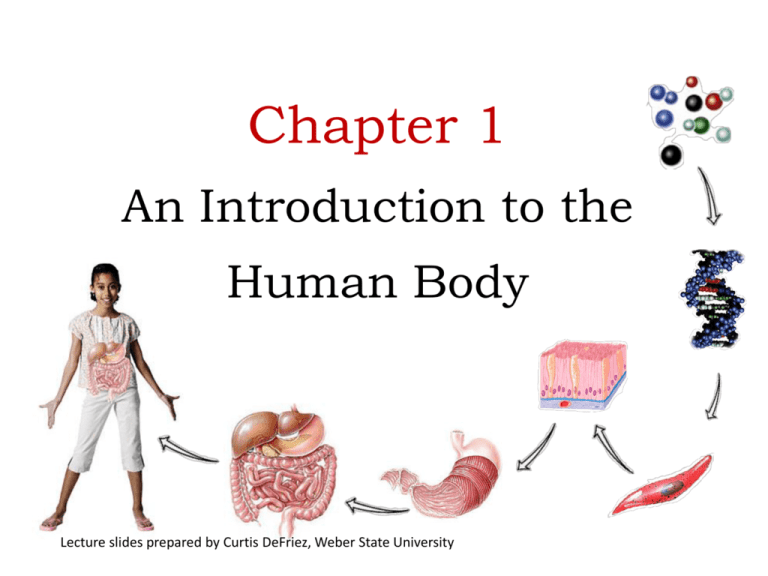
Chapter 1 An Introduction to the Human Body Lecture slides prepared by Curtis DeFriez, Weber State University Anatomy and Physiology Human Anatomy is the study of body structure. – Word is derived from the Greek and means “to cut” or “cutting backwards” (putting things together – from slices). Human Physiology is the science of body functions. – Including the study of homeostasis – (keeping the organs systems of – the body in balance) Anatomy and Physiology Human Anatomy is the study of body structure. • Word is derived from the Greek and means “to cut” or “cutting backwards” (putting things together from slices). Human Physiology is the science of body functions. • Including the study of homeostasis (keeping the organs systems of the body in balance) Anatomy and Physiology • Structure and function of the body are closely related: Structure mirrors function – Bones of the skull are heavy and secure to protect brain function. – The thin air sacs of the lungs permit movement of gases from the lungs to the blood. Anatomy and Physiology • Structure mirrors function This structure is the liver, which has the function of filtering blood and producing bile. Can you see how the function is determined by the structure, and vice versa? Subdivisions of Anatomy • Surface Anatomy is the study of form and markings of the body surface, often explored through visualization or palpation (without any “cutting”). • Gross Anatomy is the study of anatomical structures visible to unaided eye. After making the appropriate surface marking in the prior picture, the gross dissection proceeds through “cutting.” Subdivisions of Anatomy • Gross Anatomy can be studied by two general approaches: – Systemic approach (Systemic Anatomy): • Study all of the blood vessels, or all of the muscles, or all of the bones… at once. – Regional approach (Regional Anatomy) • All anatomical structures of a specific region (e.g. the thorax, or the Head and Neck) are all studied together. Subdivisions of Anatomy • Developmental anatomy is the study of the fertilized egg developing into its adult form. – Embryology is a subcategory of developmental anatomy (conception to 8th week of gestation). Subdivisions of Anatomy • Histology is the study of tissues. • Cytology, like histology, uses a microscope, but restricts the study to individual cellular structures . This micrograph is typical of an histological and cytological examination under light microscopy Subdivisions of Anatomy • Pathology is the study of anatomical changes due to disease . – Pathologists use gross inspection, as well as cytologic, histologic, and laboratory examinations to discover the source of the disease. This is a section of a human colon opened by a pathologist to reveal polyps that would become cancerous in a few years (premalignant). Clinical Connection • An autopsy is a postmortem (after death) examination of the body and internal organs performed by a pathologist. • An autopsy is usually done to : – Determine the cause of death – Identify diseases not detected during life – Determine the extent of injuries and contribution to death – Identify hereditary conditions Levels of Organization In this course, we will study Anatomy and Physiology by starting with the most basic level of organization (atoms) and “working our way up”. Levels of Organization • The chemical level of organization is discussed in Chapter 2: – Atoms – Inorganic Molecules (inorganic chemistry) – Organic Molecules (organic chemistry) Levels of Organization • The Cell is next in complexity, in fact many billions of times more complex than molecules. – Cells (and this is important!) are the basic structural and functional units of an organism . • There are many different kinds of cells in the human body. A trained cytologist can recognize under light microscopy about 210 different kinds of cells. Levels of Organization • Tissues are groups of cells that work together to perform a similar function. • While there are many different types of cells, they all work to form 4 basic types of tissues: – Epithelium Muscle – Connective Tissue Nerves Levels of Organization • Organs are structures composed of two or more different types of tissues (all but the simplest of organs have all 4 basic tissues represented.) – Organs have specific functions and recognizable shapes. • Example: The skin contains Epithelium, Connective Tissues, Nerves, and Muscle. Levels of Organization • An organ system consists of related organs with a common function. For instance, the Digestive system handles all aspects of taking in and breaking down food, absorbing nutrients, and eliminating wastes. – It includes all the organs of the mouth, esophagus, stomach, intestines, liver, gallbladder, and pancreas. – There are 11 organ systems in the body. Levels of Organization • An organism consists of a collection of organ systems. – Six important life processes: • • • • • • Metabolism Responsiveness Movement Growth Differentiation Reproduction • In health, all parts of the body must be functioning together in a process called homeostasis. Essential Life Processes • Metabolism is the sum of all the catabolic (breaking down) and anabolic (building up) chemical processes that occur in the body. • Responsiveness is the body’s ability to detect and respond to changes which might represent an opportunity… or a threat! – Decrease in body temperature – Responding to sound Essential Life Processes • Movement is any motion, including movement of tiny subcellular structures, or movement inside cells or organs. – Leg muscles move the body from one place to another. • Growth involves an increase in body size due to an increase in existing cells, number of cells, or both. – In bone growth, materials between cells increase. Essential Life Processes • Differentiation is the development of a cell from an unspecialized to specialized state. Cells have specialized structures and functions that differ from precursor cells. – Stem cells give rise to cells that undergo differentiation. • Reproduction is the formation of new cells (growth, repair, or replacement) or the production of a new individual. Homeostasis • A condition of equilibrium (balance) in the body’s internal environment. It is a dynamic condition meant to keep body functions in the narrow range compatible with maintaining life. – Blood glucose levels range between 70 and 110 mg of glucose/dL of blood. Homeostasis Interactions Animation • Communication, Regulation and Homeostasis You must be connected to the internet to run this animation. Homeostasis • Body fluids are defined as dilute, watery solutions containing dissolved chemicals inside or outside of the cell. Maintaining the volume and composition of body fluids is important. – Intracellular Fluid (ICF) is the fluid within cells – Extracellular Fluid (ECF) is the fluid outside cells • Interstitial fluid is ECF between cells and tissues Homeostasis • Some important body fluids: – Blood Plasma is the ECF within blood vessels. – Lymph is the ECF within lymphatic vessels. – Cerebrospinal fluid (CSF) is the ECF in the brain and spinal cord. – Synovial fluid is the ECF in joints. – Aqueous humor is the ECF in eyes. Homeostasis • Cellular function depends on the regulation of the composition of the interstitial fluid. – Composition of interstitial fluid changes as substances move between plasma and the interstitial fluid. – Movement back and forth across capillary walls provides nutrients (glucose, oxygen, ions) to tissue cells and removes waste (carbon dioxide). Homeostasis • Control of homeostasis is constantly being challenged by: – Physical insults such as intense heat or lack of oxygen – Changes in the internal environment such as a drop in blood glucose due to lack of food – Physiological stress such as demands of work or school • Disruptions are mild if balance is quickly restored. • Intense disruptions are often prolonged and result in disease (poisoning or severe infections) or death. Feedback System • Cycle of events: – Body is monitored and re-monitored. – Each monitored variable is termed a controlled condition. • Three basic components: – Receptor – Control center – Effector Feedback System • A receptor is a body structure that monitors changes in a controlled condition (such as body temperature) and sends input to the control center. – Specialized nerve endings in the skin act as temperature receptors – they cause a nerve to fire in response to temperature changes. Feedback System The control center sets the range of values to be maintained – usually this is done by the brain. Evaluates input received from receptors and generates output command – Output involves nerve impulses, hormones, or other chemical agents. • Brain acts as a control center receiving nerve impulses from skin temperature receptors. Feedback System • The effector receives output from the control center and produces a response or effect that changes the controlled condition. – Nearly every organ or tissue can serve as an effector. • Body temperature drops. • The brain sends an impulse to the skeletal muscles to contract . • Shivering occurs to generate heat. Feedback System • Negative Feedback systems: – Reverses a change in a controlled condition • Regulation of blood pressure (force exerted by blood as it presses again the walls of the blood vessels) • Positive Feedback systems: – Strengthens or reinforces a change in one of the body’s controlled conditions • Normal child birth Negative Feedback – Temperature Interactions Animation • Negative Feedback Control of Temperature You must be connected to the internet to run this animation. Feedback System • Blood Pressure regulation is a negative feedback system. – External or internal stimulus increases BP. – Baroreceptors (pressure sensitive receptors) detect higher BP and send a nerve impulse to the brain (interpretation). – Responses sent via nerve impulses to the heart and blood vessels cause the BP to drop (homeostasis is restored.) Blood Pressure Regulation Interactions Animation • Negative Feedback Control of Blood Pressure You must be connected to the internet to run this animation. Feedback System • Childbirth is an example of a positive feedback system: – Uterine contractions cause vagina to open. – Stretch-sensitive receptors in cervix send impulses to brain. – Oxytocin is released into the blood. – Contractions enhanced and baby pushes farther down the uterus. – Cycle continues to the birth of the baby (no stretching). Positive Feedback – Labor Interactions Animation • Positive Feedback Control of Labor You must be connected to the internet to run this animation. Clinical Connection • Diagnosis of Disease is done by assessing: – Signs and symptoms – Medical history • Collecting information about event • Present illnesses and past medical problems – Physical examination: • Orderly evaluation of the body and its function • Noninvasive techniques and other vital signs (pulse) Organ Systems of the Body • Integumentary System (Chapter 5) consists of the skin and related structures (hair, nails, and glands). – Protects body, regulates temperature, and eliminates wastes through sweat and other secretions Organ Systems of the Body • Skeletal System (Chapters 6-9) consists of the bones and joints. – Provides protection and support – Houses cells that will become red blood cells, white blood cells, and platelets Organ Systems of the Body • Muscular System (Chapters 10-11) consists of the named skeletal muscles, as well as smooth muscle and cardiac muscle. – Participates with the skeletal system to facilitate movement and maintain posture – Generates the heat necessary for warm-blooded organisms to maintain a constant body temp. Organ Systems of the Body • Nervous System (Chapters 12-17) consists of the brain, spinal cord, nerves, and sensory organs). – Senses and responds to body conditions through nerve impulses Organ Systems of the Body • Endocrine System (Chapter 18) consists of hormoneproducing cells and glands scattered throughout the body. – Regulates the body through chemical mechanisms (by releasing hormones into the blood) Organ Systems of the Body • Cardiovascular (Chapters 19-21) consists of the heart, blood, and blood vessels. – Carries blood and nutrients to specific locations – Regulates body temperature, and water balance Organ Systems of the Body • Lymphatic System and Immunity (Chapter 22) consists of the lymphatic fluid, lymph nodes, and lymphocytes – and the other associated organs of the immune system like the tonsils, spleen and thymus gland. – Transports fats and proteins to the cardiovascular system – Filters blood and protects against disease Organ Systems of the Body • Respiratory System (Chapter 23) consists of the upper airways, the trachea and major bronchi, and the lungs. – Extracts O2 and eliminates CO2 – In conjunction with the kidneys, regulates acid/base balance Organ Systems of the Body • Digestive System (Chapter 24) consists of the esophagus, stomach and intestines, and the accessory digestive glands like the salivary glands, liver, and gallbladder. – Accomplishes the physical and chemical breakdown of food and elimination of waste Organ Systems of the Body • Urinary System (Chapter 26) consists of the kidneys, ureters , bladder, and urethra. – Involved in the collection and excretion of waste products in urine, and the regulation of fluid, electrolyte, & acid/base balance Organ Systems of the Body • Reproductive System (Chapter 28) consists of the ovaries, uterus and vagina in the female, and the testes and penis in the male (along with associated organs and glands in both sexes). – Reproduction of an individual or organism Organ Systems of the Body • The systems of the body may appear to be separate and distinct, but the maintenance of most body functions requires the integration of many systems working together. – For example, regulation of body temperature involves the muscular, cardiovascular, nervous, and integumentary systems all working together to produce and distribute body heat appropriately.


